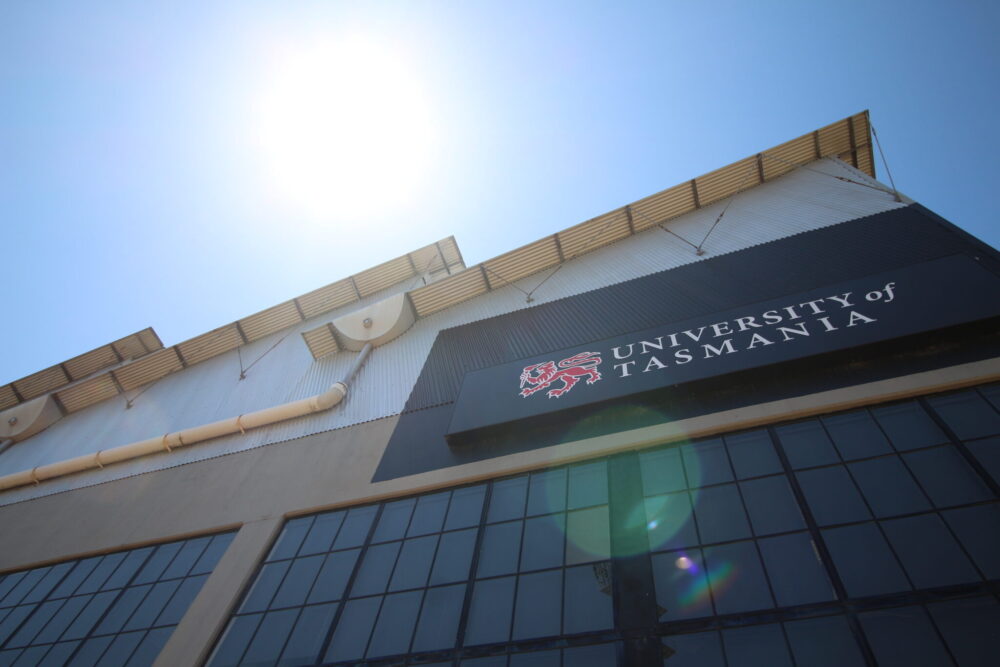The University of Tasmania’s proposed move from Sandy Bay to the nipaluna/Hobart CBD has been a subject of much contention since it was tentatively ‘announced’ in 2019. In the past few months, new tensions have arisen from a string of public statements from the University and Vice Chancellor Rufus Black about the move, as well as in the diverse chorus of voices opposed.
On ABC’s Mornings with Leon Compton, Black went on the record to note that the move to the CBD was “at its core […] about access to education first and foremost”. In doing this, he cited University data on prospective UTAS students who struggle with “distance issues” and finances in attaining university level education.
In a sense, Black is correct. As of 2021, Productivity Commission figures detail that only an alarming 58% of college aged students in lutruwita/Tasmania reach year 12 educational attainment (as compared to a 72% national average). This is all before students will even reach university enrolment, and in rural and working-class communities, the data suggests that access issues are even more pertinent. As Black and the University suggest, lutruwita/Tasmania is sorely lacking in appeal to these prospective students. So where does UTAS’ proposed move fit in with this?
The proposed CBD move, an approximate three kilometres up the road, will according to Black’s logic, remove barriers to transport and job prospects for its students. UTAS’ vision for the city will see students able to balance work and University seamlessly, with more job opportunities available for casual and part-time work in the CBD. Black and UTAS also believe it will cut down transport times for students in underrepresented educational demographics like those from the outer Northern Suburbs and Eastern Shore, thus encouraging enrolment. Although substantial and qualitative evidence has not been presented from the University to support this. Tasmanian University Student Association State President, Sophie Crothers, told Togatus that “For many students the move would also allow them to be closer to their workplaces and internships, and have larger communal spaces for students to come together to study and socialise”. She also expressed the advantages of having new “purpose built” buildings for the student population.
Recent UTAS law graduate and Young Labor President Benjamin Dudman, who moved to the Northern Suburbs of nipaluna/Hobart from the rural Central North of lutruwita/Tasmania to attend university, says that the CBD move “would not have made it easier to access university”. He believes that “It would have effectively been the same, perhaps worse if parking isn’t adequately dealt with. Rural students often don’t have the luxury of public transport so parking is essential for them”. Current UTAS student James Crossin also believes that the added CBD congestion will negatively impact his commute from the Northern nipaluna/Hobart suburb of Brighton, “If anything I would rather the campus remain in Sandy Bay. The parking situation is so much easier than in the city”. He also cites the lack of public transport alongside the lack of “time effective” transport going into the city for students in the area.
Bob Cotgrove, a local urban planner and expert in ecological development, has also called the move “a failure of urban planning”, claiming that “the notion that staff and students will arrive on buses, bikes and e-scooters is sheer fantasy”. Anecdotally, students we interviewed who live on the outskirts of nipaluna/Hobart share a similar viewpoint. Cotgrove also notes that the proposed CBD redevelopment would involve placing different departments in scattered buildings and isolated areas of the city, rather than in a central and collegial campus. According to him, this limits student interaction and affects the prospect of community building central to the university experience.
Consultation with students and the greater nipaluna/Hobart community has been a hotly contested issue in the campus debate. Indeed, despite the University’s claims it has engaged the community about the campus move, when the decision was first ‘announced’ in 2019, the University had already purchased upwards of $60 million in CBD real-estate. Even Crothers’ said she was aghast at the “very little tangible student input into decision making” involved in the consultation process between UTAS and the broader community.
Concerns that the University’s priorities are misplaced have also been raised over the campus move. Indeed, Black’s CBD cash splash comes after the University was forced to cut hundreds of courses in 2020 as a cost-saving exercise after the advent of coronavirus. This streamlining in courses has also coincided with the University’s decision to largely scrap in-person lectures in favour of online delivery as well as its controversial support of the ‘Job-Ready Graduates Package’ which will include fee hikes of 113% to humanities degrees.
The costly CBD decision also comes at a time when UTAS’ labour practices have come heavily under fire. Earlier this year, the University was accused of wide-scale wage theft dating back to 2013, with underpayments related to penalty rates being misapplied and minimum engagement periods not being honoured. More recently, the UTAS Law Faculty administration has made headlines for their high rate of staff turnover, with many staff members across the University also employed in precarious contracts.
With some then questioning whether money would be better spent improving student experience and labour standards at the University, when asked if renovations could simply be made to upgrade the existing campus, Black simply told Compton “no”. Some, like Save UTAS proponent Ben Lohberger, allege a strategy of “forced obsolescence” in regards to the current Sandy Bay campus, with the aim of justifying the city move.
Amid the public relations disaster over the University’s controversial move, Black has invested in efforts to sway worsening public opinion. This has included promoting the CBD move through regular newspaper advertisements and sponsored posts on Facebook. The University has also enlisted the help of Instagram influencer Lillian ‘FlexMami’ Ahenkan to bolster their image. In a move that has baffled some, UTAS has gone so far as to hire controversial former Glenorchy Mayor and Liberal/Independent MP Sue Hickey to win over those opposed to the move.
A petition from the Save UTAS Campus group that has attracted 1732 signatures has prompted a public meeting at the City Hall that will be held on May 11th at 7pm. All are invited to attend the free event to discuss the future of the University.








